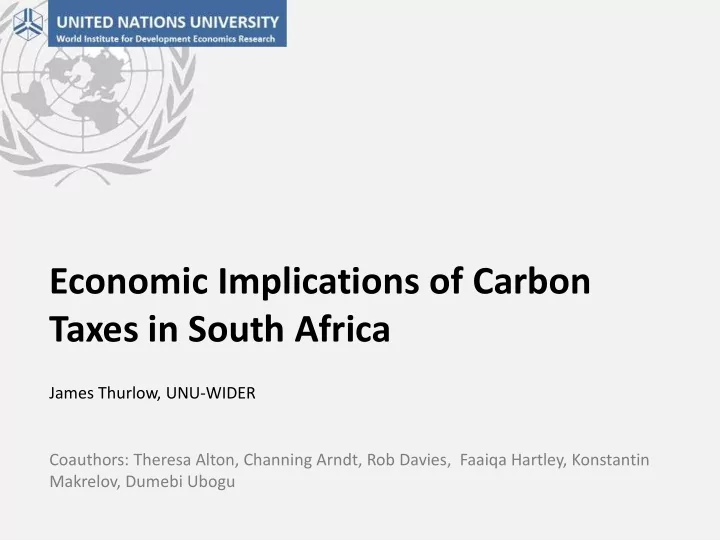

Economic Implications of Carbon Taxes in South Africa James Thurlow, UNU-WIDER Coauthors: Theresa Alton, Channing Arndt, Rob Davies, Faaiqa Hartley, Konstantin Makrelov, Dumebi Ubogu
Carbon Emissions • South Africa must produce more energy but also reduce emissions – Pledged to lower emissions by 42% by 2025 (relative to business-as-usual) Low income Lower middle income Upper middle income High income Emissions per unit of energy use UK Denmark South Africa China USA UAE Finland Norway Sweden Current growth path Iceland Tanzania Zambia Mozambique Low carbon growth path DR Congo Source: WDI Energy use per person Notes: Log scale, Energy use in oil equiv.
Energy-Economy Model • South African General Equilibrium (SAGE) model • 2005 social accounting matrix (SAM) – 54 industries, 7 factors of production, 14 household groups • Resource constraints – Upward sloping labor supply curves for less-educated workers – “Putty clay” capital and endogenous capital accumulation • Macroeconomic closures – Fixed current account with flexible real exchange rate – Savings-driven investment
Energy Production Coal-fired Nuclear Hydropower Electricity Gas-fired Partly exported Coal Renewables Final users Natural gas Industries Waste Households Government Investment Coal-to-liquid Gas-to-liquid Petroleum Imported Crude oil Oil refining Feedstock Biofuels
Energy Use Energy efficiency = Energy input Industry output • Energy efficiency determined by… – Existing technologies – Energy prices (provided there is new investment) – New investment (provided the price rises)
Simulations 1. Domestic carbon tax Applied to all fossil fuels burned in South Africa – Starts at US$3 per ton CO 2 in 2012 and rises gradually to US$30 in 2022 – Uniform reduction in indirect sales tax rates (distribution neutral) – 2. Domestic border tax adjustment on embodied carbon As above, but rebate exporters and tax imports at same carbon tax rate – 3. Foreign border tax adjustment South African exports are taxed at foreign border – Starts at US$1.5 per ton CO 2 in 2012 and rises gradually to US$15 in 2022 – 4. Recycling revenues Instead of sales taxes, reduce corporate taxes or increase social transfers –
Electricity Investments Base Case (BAU) Policy-Adjusted Emissions 3 Cost: US$108 bil. Cost: ??? Cost: US$171 bil. Emissions: -19% of BAU by 2025 Emissions: -42% of BAU by 2030 100 100 100 Gas 90 90 90 Renewables 80 80 80 System capacity (GW) Hydro 70 70 70 Nuclear 60 60 60 Coal 50 50 50 40 40 40 30 30 30 20 20 20 10 10 10 0 0 0 2005 10 15 20 25 30 2005 10 15 20 25 30 2005 10 15 20 25 30
Results: Emissions Reductions • A US$30 per ton CO2 carbon tax achieves emissions targets • Ring-fencing of electricity means large reduction in other sectors Changes in GHG emissions, 2010-2025 Business- Deviation from “business-as-usual” scenario, 2025 (%) as-usual, Policy- Production Consumption Foreign 2010 Adjusted carbon tax carbon tax carbon tax CO 2 emissions (mil.mt) using the reference approach 447.5 -8.6 -36.6 -36.2 -19.6 Electricity generation 237.0 -19.0 -19.0 -19.0 -19.0 Other sectors/households 210.5 0.0 -51.3 -50.5 -20.1 CO 2 emissions (mil.mt) using n.a. the sectoral approach 397.4 -40.4 -41.4 -21.0
Results: GDP and Employment Losses Economywide abatement costs Sectoral sources of losses GDP 1.4 Services Decline in GDP or employment , 2025 (%) 1.4 $40 Construction Carbon tax (US$/mt) Decline in GDP, 2025 (%) 1.2 $35 Manufacturing 1.2 Mining $30 1.0 1.0 Agriculture $25 0.8 0.8 $20 $15 0.6 0.6 $10 0.4 0.4 $5 0.2 0.2 $2.5 Employment 0.0 0.0 0 5 10 15 20 25 30 35 40 0 10 20 30 40 Carbon tax (US$/mt) Decline in GHG emissions, 2025 (%)
Results: Income Distribution Consumption growth incidence curves Deviation in consumption, 2025 (%) 6 5 4 3 Corporate tax 2 1 Sales tax 0 -1 Retaliatory tax -2 Social transfers -3 -4 1-10 11-20 21-30 31-40 41-50 51-60 61-70 71-80 81-90 91-96 97 98 99 100 Ranked population per capita expenditure percentiles
Conclusions • Carbon taxes reduce national welfare and employment – Absorption and employment fall by 1.2 and 0.6 percent, respectively, by 2025 – These effects are small in annual growth rate terms (less than 0.1 %-points) • Welfare and employment losses are larger if RSA’s trading partners unilaterally impose BTAs on South African exports • Domestic BTAs reduce welfare and employment losses while maintaining the same emissions reductions • Mode of revenue recycling strongly influences growth and distributional outcomes (i.e., trade-offs)
Recommend
More recommend